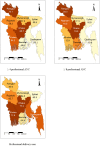Continuation of education after marriage and its relationship with professional maternal healthcare utilization among young adult women in Bangladesh
- PMID: 39739905
- PMCID: PMC11687904
- DOI: 10.1371/journal.pone.0316117
Continuation of education after marriage and its relationship with professional maternal healthcare utilization among young adult women in Bangladesh
Abstract
The relationship between women's education and the utilization of adequate maternal healthcare services has been well documented. However, the literature on how the continuation of women's post-marital education affects the utilization of maternal healthcare services is limited. Therefore, this study investigates such relationships. This study aims to examine the association between the continuation of education after marriage and the utilization of antenatal care (ANC) (≥ 4 ANC, a four-contact model; and ≥ 8 ANC, an eight-contact model) and delivery assistance received from skilled professionals among currently married young adult women in Bangladesh. This was a cross-sectional study of 1,731 young adult women aged 15-29 years from the Bangladesh Demographic and Health Survey, 2017-18. We adopted a multivariable logistic regression analysis to examine the relationships of interest. Results show that 60.9% of women received four or more professional ANCs, 15.5% received eight or more professional ANCs, and 69.9% received professional delivery care. Compared to young adult women who did not continue their education after marriage, women who continued were more likely to utilize ≥4 professional ANC (adjusted odds ratio [AOR] = 1.47; 95% confidence interval [CI] = 1.11-1.94), ≥8 professional ANC (AOR = 1.22; 95% CI = 1.01-1.74), and professional delivery care services (AOR = 1.78; 95% CI = 1.29-2.44). In addition, age at marriage, exposure to television, and the wealth index were also found to be associated with the utilization of professional maternal healthcare services. This finding implies that implementing policies and programs that encourage girls to continue their education after marriage could potentially increase the utilization of professional ANC and delivery care services in Bangladesh.
Copyright: © 2024 Howlader et al. This is an open access article distributed under the terms of the Creative Commons Attribution License, which permits unrestricted use, distribution, and reproduction in any medium, provided the original author and source are credited.
Conflict of interest statement
None declared.
Figures



References
-
- World Health Organization, Trends in maternal mortality 2000 to 2020: estimates by WHO,UNICEF, UNFPA, World Bank Group and UNDESA/Population Division. 2023, Geneva: World Health Organization;.
-
- Campbell O.M. and Graham W.J., Strategies for reducing maternal mortality: getting on with what works. Lancet, 2006. 368(9543): p. 1284–1299. - PubMed
-
- World Health Organization, Making pregnancy safer: the critical role of the skilled attendant: a joint statement by WHO, ICM and FIGO. 2004, Geneva: WHO.
-
- De Bernis L., et al.., Skilled attendants for pregnancy, childbirth and postnatal care. British Medical Bulletin, 2003. 67(1): p. 39–57. - PubMed
MeSH terms
LinkOut - more resources
Full Text Sources
Medical

